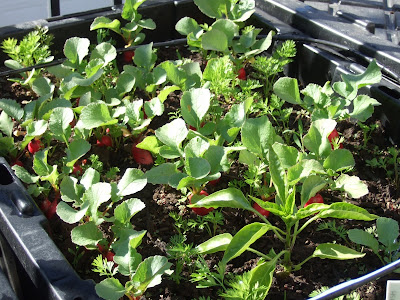
These are one of my favorites-they are so tasty and just massive.
WE PLANT IT. WE GROW IT. YOU EAT IT.









 Spring is in the air and its time to get those peppers, tomatoes and zucchini seedlings in the ground. You might feel left out if you're lacking ground to plant in (by that we mean soil), but fear not! The Yard Farmer has an innovative solution for those with unused patio and balcony space -the container garden.
Spring is in the air and its time to get those peppers, tomatoes and zucchini seedlings in the ground. You might feel left out if you're lacking ground to plant in (by that we mean soil), but fear not! The Yard Farmer has an innovative solution for those with unused patio and balcony space -the container garden.



Immokalee is the tomato capital of the United States. Between December and May, as much as 90 percent of the fresh domestic tomatoes we eat come from south Florida, and Immokalee is home to one of the area’s largest communities of farmworkers. According to Douglas Molloy, the chief assistant U.S. attorney based in Fort Myers, Immokalee has another claim to fame: It is “ground zero for modern slavery.”
For every 32-pound basket you pick, you receive a token typically worth about 45cents—almost the same rate you would have gotten 30 years ago. Working at breakneck speed, you might be able to pick a ton of tomatoes on a good day, netting about $50. But a lot can go wrong. If it rains, you can’t pick. If the dew is heavy, you sit and wait until it evaporates. If trucks aren’t available to transport the harvest, you’re out of luck. You receive neither overtime nor benefits. If you are injured (a common occurrence, given the pace of the job), you have to pay for your own medical care.
Although industrial composting is on the rise, as the statistics above indicate, individuals aren’t doing as much as they could do make sure more food waste is composted. Yard Farmer insists that its customers compost, and we make it easy for them to do so by setting up an easy-to-use composting system at each of our customers’ homes. That said, we believe that the more you know about composting, the more comfortable you’ll be with the process. Once you get used to it, composting is even less difficult than sorting out glass, plastic and aluminum trash for recycling.
What is compost?
Compost is organic material that we use to amend soil. Composting has been occurring in nature since the dawn of plant life on this planet. As vegetation from trees and other plants falls to the ground, it slowly decays, which provides minerals and nutrients for plants, animals and microorganisms.
The composting process that most gardeners use, however, produces higher temperatures that kills pathogens and weed seeds. It also encourages the growth of microorganisms such as bacteria and fungi that break down the organic material in the compost pile into humus. When added to soil, this black, earthy material increases the level of nutrients available to plants and helps the soil retain moisture.
Studies have also demonstrated that compost can reduce incidences of plant diseases and pests, help eliminate the need for chemical fertilizers and produce higher crop yields.
What can I put in my compost bin?
The EPA has a great set of basic guidelines for composting. Following are guidelines on what’s safe to add to your compost pile and what isn’t (and why).
What to Compost
Cardboard rolls
Clean paper
Coffee grounds and filters
Cotton rags (non-oily only)
Dryer and vacuum cleaner lint
Eggshells
Fireplace ashes
Fruits and vegetables
Grass clippings
Hair and fur
Hay and straw
Houseplants
Leaves
Nut shells
Sawdust
Shredded newspaper
Tea bags
Wood chips
Wool rags (non-oily only)
Yard trimmings
What Not to Compost and Why













"I guess if it's irreversible, to me it seems all the more reason you might want to do something about it," she says. "Because committing to something that you can't back out of seems to me like a step that you'd want to take even more carefully than something you thought you could reverse."









